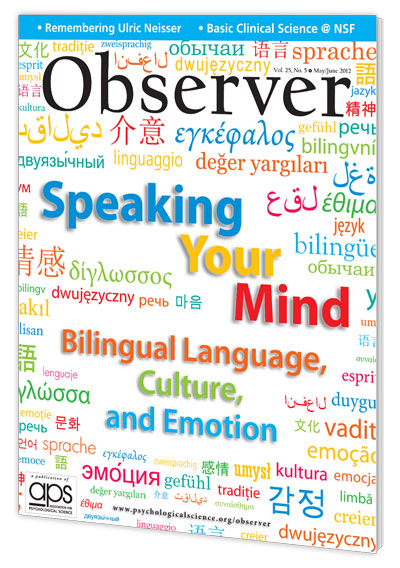Cover Story
Speaking Your Mind
 In much of the world, speaking multiple languages is the norm. Virtually everyone in the Netherlands and Norway speaks passable English, and it’s possible to travel, or even get a doctorate, in many European countries without speaking the local language at all.
In much of the world, speaking multiple languages is the norm. Virtually everyone in the Netherlands and Norway speaks passable English, and it’s possible to travel, or even get a doctorate, in many European countries without speaking the local language at all.
Despite widespread multilingualism, most research on the psychology of language has focused on monolingual English speakers. But in the last decade or so, psychological scientists have started studying people who speak multiple languages. This research has included how bilinguals’ brains manage multiple languages, how they feel emotional words in their different languages, and whether their behavior and personality change when they speak different languages.
“Until recently, bilinguals were considered to be rather odd,” says Judith Kroll, an APS Fellow at Pennsylvania State University. Bilinguals were studied as interesting oddities, like people who have had strokes or dyslexic children, but they weren’t considered to be the normal case. Now, though, scientists have started to catch up. “The argument we’ve made is that bilinguals provide a lens for observing issues of interactions, plasticity, and change that we otherwise just wouldn’t see,” Kroll says.
Kroll and her collaborators study how bilinguals process language. “The bilingual is a mental juggler,” she says. Rather than entirely turning off one language and turning on the other, people who speak two languages keep both languages active all the time. Particularly in reading and listening, there is evidence that both languages are active in the brain. In speaking, the bilingual has to take the reins, keeping track of which language they’re speaking.
And learning a new language also affects a person’s relationship with their first language. Kroll and her colleagues did a study on American students who were learning Spanish in Salamanca, Spain. They found that those who were immersed in Spanish much of the time — not just in class — were less able to access English; they were apparently suppressing it so they could cope with a new language.
By measuring brain activity, Kroll has found that control areas of the brain are active when bilinguals are planning to speak in their second language. Many studies have found that people who speak multiple languages are very good at executive control, probably because of their constant practice at tamping down one language and keeping the other one flowing. A study by Ellen Bialystok of York University and colleagues found that bilinguals with Alzheimer’s disease were diagnosed 4.3 years later, and they reported symptoms starting 5.1 years later than monolinguals. Another paper coauthored by Bialystok, which will appear in an upcoming issue of Psychological Science, suggests that poor immigrant children who speak both Portuguese and Luxembourgish have better control — selective attention and inhibitory suppression — than other children of similar socioeconomic status who only speak Portuguese.
Most of the studies on bilingualism and its beneficial effects on cognition have been correlational, Kroll says. The next step is to figure out “what it is about what bilinguals do with language that has these really remarkable consequences,” she says.
While doing all this mental juggling, bilinguals are also managing emotional content in two languages. Many bilinguals say that they feel things differently in each language, says Catherine Caldwell-Harris at Boston University. She has studied how bilinguals experience emotion in their languages and also how their experiences change depending on when they learned the second language. In one study, Caldwell-Harris compared Spanish-English bilinguals who grew up in the United States with bilinguals who learned English later. Each person was presented with emotional expressions and neutral words, half in English and half in Spanish. While they read or heard the expressions, their skin conductance was measured, which can change in response to emotional stimuli. People responded to many emotional words similarly in their two languages. But childhood reprimands like “Shame on you!” or “Don’t do that!” elicited a stronger response in Spanish for people who learned English late — who were yelled at mostly in Spanish as children — while, for people who learned English early, these reprimands produced the same response in English and Spanish.
While many researchers think the change in language learning with age is because of changes in the brain, Caldwell-Harris thinks there’s more to it. Children who immigrate at different ages have very different social experiences. Young children have to use English to get by on the playground, while teenagers have more chances to seek out friends and socialize with other people who speak their native language, and adults might only use the second language when they absolutely have to, such as in banks and stores. “Brain plasticity plays a role, but we’ve got to keep in mind a lot of other factors,” she says.
The differences in how emotions feel in a bilingual individual’s first and second languages have implications for marketing. Stefano Puntoni of the Rotterdam School of Management got interested in studying multilingualism in part because of his own experience. When he was getting his PhD in London, he noticed that people who were perfectly polite and proper in Italian swore like sailors when they spoke English — probably because the curse words didn’t feel as emotional in a foreign language. To test emotionality in multiple languages, he found Dutch-French-English trilinguals in subway and train stations — trilinguals are pretty easy to come by in Brussels — and showed them a slogan in Dutch and French. (The study’s instructions were in English.) Native speakers of both Dutch and French felt the slogan was more emotional in their first language than in their second language. “If the brand name is designed to communicate strong emotions, which in marketing we believe is really important, then doing that in the native language is much easier because it’s easier to connect emotionally with people,” Puntoni says.
The connection between language and emotion gets more complicated when you ask people how they feel. Puntoni has studied how people respond to surveys in different languages, and he found that when they’re using their first language to answer a survey, they actually give lower ratings on emotion than when they do the same survey in another language.
In one study, Dutch university students who were proficient in English watched an animated short movie (the language-free Pixar film Presto, about a magician and his rabbit) in which the beginning and end were edited to remove any text. Then they rated the intensity of five positive and five negative emotions on a seven-point numerical scale. Some surveys had the emotion words in Dutch, and some had the emotion words in English. The participants gave more intense scores for English emotion words than Dutch emotion words. “What’s happening is that people who are native speakers would tend to be more conservative — they would not endorse extreme labels,” he says. Puntoni has shown this effect in different contexts. It might apply on a website in which people are asked to rate something on a scale from “I hate it” to “I love it.” “You as an English native speaker might be reluctant to say that you hate something, but I’m not a native English speaker. I can hate a lot of things.” When speaking Italian, Puntoni says, he would be much less likely to use the equivalent word for hate, odio.
When bilinguals read in their second language, they spontaneously activate the translation of the native language in their mind, says Guillaume Thierry at Bangor University in Wales. When Chinese speakers read in English, their brain activity shows that they are connecting the English words with their Chinese translations.
But Thierry’s new research finds that this doesn’t always happen; the emotional resonance of the words is important. For a study soon to be published in the Journal of Neuroscience, pairs of English words were presented to students from China who were proficient in English. Some of the words were neutral, some were unpleasant words like “violence,” and some were associated with positive emotions. The Chinese translations of some of the word pairs sounded similar — a sort of prime that the participants didn’t know about. Similar to earlier studies, the researchers could tell that the Chinese translations were activated when bilinguals read English words. But it only happened for positive and neutral words. “To our incredible surprise, what we found was that when the word was negative, the priming effect that was the connection between the two words disappears,” Thierry says.
This means that the bilinguals’ brains were apparently declining to translate the words into Chinese. “In other words, your brain makes very high-level decisions on what should come into the language system without consulting with your consciousness,” Thierry says. It seems like the brain unconsciously protects bilinguals from feeling the negative words by stopping them from being translated into their native language.
Thierry’s personal experience, like that of many bilinguals, has more to do with positive emotions. He is a French researcher living in Britain. “It never comes to my mind to say to my daughter, who is a five-year-old, ‘I love you’ in English,” he says. “It would be completely without substance. I don’t know how she would take it, because she’s a native bilingual, which is different. But in my case English will remain, until I die, an alien language.”
So the evidence suggests that many people, like Thierry, feel things differently in their two languages. Some research has also found that people behave differently depending on what language they’re speaking.
Most cross-cultural psychology research has looked at comparing groups — finding that people from Asian cultures tend to be more group-oriented and self-effacing, and people from Mexico tend to be more gregarious, for example.
Nairán Ramírez-Esparza at the University of Washington has done that kind of work, analyzing the language of people in Mexico and the United States to describe their personalities and what they value. She has also studied how these two cultures show up within one person, studying how Mexican-American bilinguals behave when they’re speaking each of their two languages. For example, bilinguals were recorded on video responding to the same interview questions in Spanish and in English. Then reviewers watched the videos with the sound off and rated the speakers’ personalities. Ramírez-Esparza knew from earlier research that people from Mexico put a high value on simpatía — the quality of being likeable, easygoing, fun to be with, polite, affectionate, and sharing feelings with others. Consistent with that value, the bilinguals in the videos seemed more agreeable when speaking Spanish than when speaking English — even though the sound was off.
Oddly though, bilinguals rated themselves lower on simpatía when they answered a questionnaire in Spanish compared to a questionnaire in English. Eventually, Ramírez-Esparza and her colleagues figured out the puzzle: Another aspect of simpatía is modesty, and people didn’t want to appear too self-aggrandizing by rating themselves as extremely simpático. “They are indeed switching personalities, in the sense that their cultural biases are influencing the way they respond to self-reports,” she says.
This research highlights the fact that bilinguals are often also bicultural. In this case, language was what activated the switch between cultures. “Language is one of the main vehicles of culture,” says Verónica Benet-Martínez of Pompeu Fabra University in Barcelona, who has collaborated with Ramírez-Esparza.
Some people have hypothesized that people with two cultures might act like a sort of average between the two cultures. But, instead, they seem to perform cultural frame-switching, operating in one culture or the other depending on the context. “Biculturals and bilinguals are like two people within one,” Benet-Martínez says. For example, in one study, she and her colleagues showed Chinese-American biculturals an image of a fish swimming ahead of a group of fish. But first, each person was primed with either Chinese or American references. Even though the priming was all done in English, people who had been primed to think about Chinese culture were more likely to say the fish was out in front because he’d been kicked out by the group or because the group told him to go ahead and find food for them. People who had gotten the American prime said the fish was going ahead because it is his idead or he wanted to.
Different bicultural people find different ways to integrate their two sides, Benet-Martínez says. Some people feel that their two sides are in conflict, while others find a balance. In a meta-analysis about to be published in the Journal of Cross-Cultural Psychology, she and Angela Nguyen collected studies on people who are ethnic minorities or immigrants and found that those who embrace both the ethnic and host cultures have better mental health and social adjustment than either people who stick to the minority culture or those who assimilate completely, leaving their first culture behind. This body of research confirms that “success as an immigrant or ethnic minority is not contingent on abandoning your culture and only learning the host culture,” she says. “People who have both are actually doing better, mentally.”
Even people who don’t identify as bicultural can pick up part of another culture by learning its language, Benet-Martínez says. “If you speak perfect Russian, you read Russian novels, you go to Russia sometimes, you watch Russian movies — before you know it, you are internalizing that culture and you are becoming bicultural.” It’s a matter of degrees, she says; you may not become as Russian as Vladimir Putin, but you will still have a bit of Russian in you.
Researchers still have a lot to learn about bilingual people — like how precisely knowing a second language improves the brain, or what happens when a third language is added. And bilinguals aren’t interesting only by themselves, but also for what they show about how languages work in general. Future research with bilinguals may help answer questions about how languages are produced and perceived in the brain, and what the words people choose say about them.





Comments
I speak four languages (German is my fourth and weakest). I have known and felt for a long time that I take on a different personality for each language that I speak. Your article clarified what I had suspected!
In Turkish it is said “Bir lisan bir insan” = one language, one person…Personally, with each language I learned, I have something which makes me close to the natives of this language, even foreign languages learnt at school, or in another context.
I think that each language will impose a set of “values” on the speaker. It,s difficult to grade and compare levels of feelings through language(s).Different levels of profficiency (it`s impossible to have a fully and equally bilingual informant) affect results.Simpatico is highly diverse even among Spanish dialects.
Maybe bilinguals don`t “switch” personalities, they modifie thier own linguistic standards.
So true. What I hope reading such an article does is encourage others to study new languages. Those who grow up multi-lingual don’t perceive the way that their brains adapt to accommodate the additional languages since the learning occurs simultaneously, but those who study them later–such as myself–notice a stark contrast in the way I think. I now speak 6 languages, and when expressing myself in my native English, I often find myself looking for words that simply aren’t there. It’s often because I’m trying to express a concept that I learned from Swahili, German, Japanese, Arabic or French, but which doesn’t have a proper counterpart in English usage.
Excellent article! I love to read about bilingualism and how people determine when to say what in each language.For instance, I prefer to scold my son in Spanish, but I can talk to him in English if it is only about topics that are not related to his behavior, I guess it is due to the fact taht I have talked to him in Spanish since he was a baby. He learned English when he was 14 when he moved to live in US. Now he is 22, but I still prefer to talk with him about personal issues in Spanish. With my husband I speak in English all the time,but he is not bilingual. Thank you!
Outstanding new research. My field is sencond language teaching and business communication. Everything expressed in this article can happen in one first meeting of multiple cultures in one room to discuss business. Everyone trying to communicate, yet multiple cultures/feelings/opinions flying through the phrases. It takes great listening skills and letting go sometimes of your native language to hear and interact sincerely. A true brain gymnasium.
Each language is a world and no word can be translated exactly
We should have a language for philosophy one for economy one for history and so on
Learning a new language is the gymnastics of the brain!
APS regularly opens certain online articles for discussion on our website. Effective February 2021, you must be a logged-in APS member to post comments. By posting a comment, you agree to our Community Guidelines and the display of your profile information, including your name and affiliation. Any opinions, findings, conclusions, or recommendations present in article comments are those of the writers and do not necessarily reflect the views of APS or the article’s author. For more information, please see our Community Guidelines.
Please login with your APS account to comment.